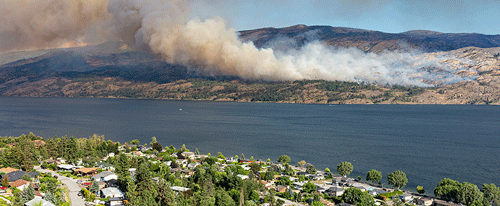Protect your home from wildfires with ember-resistant vents

In recent years, wildfires have become both more frequent and more destructive. According to the National Oceanic and Atmospheric Administration (NOAA), wildfires caused $81.6 billion in damage from 2017 to 2021, an almost 10-fold increase over 2012 to 2016, when damages totaled $8.6 billion.1
Homeowners can take a number of actions to protect their homes from wildfires, including maintaining a defensible perimeter around your home, trimming trees and removing deadwood, and installing water tanks, pumps, and sprinkler systems. In addition, one of the most important steps that homeowners living in fire-prone areas can take is installing high-quality ember-resistant vents.
The right vents can make a difference
Wind-blown embers — burning pieces of bark, twigs, pinecones, needles, and other vegetation — can travel for many miles to enter and ignite homes. These flying embers are the primary cause of fires that destroy or damage homes during wildfires.2 Embers can enter homes through vents, land on combustible materials, and ignite homes from the inside.
Fortunately, you can lower the risk of your home catching fire from errant embers by installing ember-resistant vents. There are several types of ember-resistant vents available in the marketplace that help prevent embers from entering homes, while still fulfilling their purpose of allowing outside air to circulate and prevent moisture buildup inside your home. Key components to consider when selecting ember-resistant vents include:
- Design — Ember-resistant vents may use a combination of wire mesh, baffles, louvers, and other design elements to block embers. For some types of vents — such as eave and cornice vents — mesh alone is not sufficient to block embers.2
- Materials — Ember-resistant vents are made of a variety of materials, including stainless steel, galvanized steel, copper, and intumescent coatings. Fiberglass and plastic can melt and burn; they should not be used for vents or mesh.
- Standards and Approvals — Some ember-resistant vents are identified by the International Code Council (ICC) and have achieved equivalency to the Underwriters Laboratories of Canada (ULC) Standard. Look for vents that meet this performance benchmark: ULC Standard: Fire Endurance Test of Building Construction and Materials, CAN / ULC-S101-14 [ICC-ESL 1445], such as Vulcan Vents.3
In some instances, vents may be retrofitted for ember resistance by covering openings with 1/8-inch or 1/16-inch wire mesh. Newer homes in areas prone to wildfires may already have ember-resistant vents installed as part of their original construction. If you already have ember-resistant vents in place, consider having them inspected by an expert to determine if they are in good condition and provide sufficient protection against embers.
Be sure to identify all areas of your house that have vents. You may need to replace or retrofit foundation vents, dormer vents, eave vents, soffit vents, gable vents, cornice vents, and others. Consider working with an experienced contractor for installation and guidance on maintaining sufficient venting to control moisture.
Ember-resistant vents are just one part of fire protection
While ember-resistant vents can help protect a home from wildfire damage, they should be recognized as only one part of a more extensive home hardening process. Homeowners should also consider other physical upgrades they can make to their homes to thwart embers and fire. These upgrades include installing fire-resistant roofs and heat-resistant windows, re-siding with fire-resistant materials, and sealing gaps around eaves and windows.
Even as you take steps to protect your home, it’s also a good idea to prepare for the worst. Key steps you can take to prepare for a wildfire include:
- Develop and practice a family evacuation plan, with two exit routes if possible.
- Prepare a “go bag” for rapid evacuation with essentials such as water, nonperishable food, a first aid kit, and a flashlight.
- Store important documents in a fire-resistant safe or away from your home.
- Learn how to shut off your natural gas at the meter.
This document is advisory in nature and is offered as a resource to be used together with your professional insurance advisors in maintaining a loss prevention program. It is an overview only, and is not intended as a substitute for consultation with your insurance broker, or for legal, engineering or other professional advice.
Chubb is the marketing name used to refer to subsidiaries of Chubb Limited providing insurance and related services. For a list of these subsidiaries, please visit our website at www.chubb.com. Insurance provided by Chubb Insurance Company of Canada or Chubb Life Insurance Company of Canada (collectively, “Chubb Canada”). All products may not be available in all provinces or territories. This communication contains product summaries only. Coverage is subject to the language of the policies as actually issued.

Have questions?
Contact a broker today.